Analysis of Traffic Operation Characteristics and Calculation Model of the Length of the Connecting Section between Ramp and Intersection
Abstract
1. Introduction
2. Experimental Method
2.1. Traffic Survey
2.1.1. Methods and Contents
2.1.2. Location and Time of the Traffic Survey
2.2. Existing Design Parameters of the Connecting Section between the Ramp and Intersection
2.2.1. The Trial Connecting Section between On-Ramp and Intersection
2.2.2. The Trial Connecting Section between Off-Ramp and Intersection
3. Experimental Results and Discussion
3.1. Traffic Operation Characteristics of the Connecting Section between Ramp and Intersection
3.1.1. Traffic Operation Characteristics of the Connecting Section between the On-Ramp and Intersection
3.1.2. Traffic Operation Characteristics of the Connecting Section between the Off-Ramp and Intersection
- Traffic flow density: The traffic flow density mainly affects the length of the queuing section in the connecting section. When there is a traffic jam on the road, the traffic flow will form a wave in the opposite direction, which is the same as the sound wave, into the congested section. This wave will lead to traffic chaos on the road before the bottleneck section [26].
- Vehicle speed: The speed of vehicles directly affects the length of the connecting section, and the lane-changing behavior of vehicles in the current stage is compulsory [27], and only when the vehicle gap is sufficiently large will the driver change lanes [28]. The speed of vehicles in the current stage is an important factor affecting the critical gap, there is a positive correlation between them.
- Signal cycle and phase: Signal cycle and phase will affect the vehicle delay. The longer the vehicle delay, the longer the queue length. In addition, the service level of the road is not the same under different signal cycles, so the signal cycle and phase of the intersection will have a great impact on the queue length of the connecting section.
- Road capacity and service level: The road capacity and service level will affect drivers’ driving speed and lane-changing behavior, so it affects the length of the connecting section to a certain extent.
3.2. Calculation Model of the Length of Connecting Section between the Ramp and Intersection
3.2.1. Calculation Model of the Length of Connecting Section between the On-Ramp and Intersection
- (1)
- Length of the Merging Section: L1
- (2)
- Length of the Weaving Section: L2
- The distance that a vehicle needs to travel when looking for a gap to insert: L21
- According to the law of linear motion with uniform speed change, the distance that a vehicle moves forward when changing lanes: L22
- According to the law of linear motion with uniform speed change, the distance for the driver to resume driving after the vehicle completes the lane-changing: L23
- (3)
- Length of the Queuing Section: L3
- (4)
- Length of on Ramp Connecting Section: L
3.2.2. Calculation Model of the Length of Connecting Section between the Off-Ramp and Intersection
- (1)
- Length of the Merging Section: L1
- (2)
- Length of the Weaving Section: L2
- (3)
- Length of the Queuing Section: L3
- (4)
- Length of connecting section of off-ramp: L
3.3. Traffic Simulation Based on VISSIM
3.3.1. Traffic Simulation under the Calculated Length of On-Ramp Connecting Section
3.3.2. Traffic Simulation under Calculated Length of Off-Ramp Connecting Section
4. Conclusions
- The connecting section is divided into the merging section, the weaving section and the queuing section, and the traffic operation characteristics of each section were analyzed. The traffic operation characteristics of the merging section are the same as that of the basic section. The vehicles in the merging section are basically decelerating in the case of traffic congestion, and the approximate acceleration value is 1 m/s2 according to the actual investigation. The traffic operation characteristics of the weaving section mainly include the car-following characteristics and lane-changing characteristics, and the lane-changing behavior of the weaving section is mostly mandatory. The queuing of the on-ramp connecting section is caused by too many vehicles entering the ramp, which can be considered as a single channel queuing service (M/M/1) system. The queuing section of the off-ramp connecting section refers to the vehicle queuing caused by the influence of intersection signal lights or traffic congestion.
- Based on the traffic survey results of the connecting section near the intersection of the Xiongchu Avenue viaduct and Guanggu Avenue and that near the intersection of the Xiongchu Avenue viaduct and Minzu Avenue, it can be seen that under the current length of the connecting section, the traffic flow is large in the morning rush hours, which cannot pass smoothly under the control of the signal lights, resulting in queuing and congestion.
- The calculation model of the length of connecting section between the ramp and grade intersection is established. Based on lane-changing theory, acceptable gap theory and queuing theory, the length calculation model of the connecting section between the on-ramp and grade intersection was established; based on lane-changing theory, acceptable gap theory, wave in traffic and the Webster vehicle delay model, the length calculation model of connecting section between the off-ramp and grade intersection was established.
- Combined with the practical cases, VISSIM was used to simulate the traffic flow in the connecting section. The simulation results show that the travel time, delay time and queue length of vehicles in the connecting section are significantly reduced under the calculation length of the model, and the overall traffic operation state is greatly improved, which verifies the rationality of the calculation model of the connecting section length.
Author Contributions
Funding
Data Availability Statement
Conflicts of Interest
References
- Wang, X. A view of Beijing’s traffic policy: Evaluation on the policies released in 2010 to ease traffic congestion. Macrosc. Manag. Public Policy 2021, 3, 8. [Google Scholar] [CrossRef]
- Qiu, Y.; Zhang, Y.; Cai, L.; Zhu, W. Traffic Analysis and Improvement Measures of On-Ramp Joints of Elevated Expressways. In Proceedings of the 2014 International Conference of Logistics Engineering and Management, Shenyang, China, 24–26 May 2014. [Google Scholar]
- Hao, Y.; Sun, L.; Xu, T.; Du, Y. Analysis of traffic congestion on urban expressway and congestion threshold identification. J. Tongji Univ. Nat. Sci. 2008, 5, 36. [Google Scholar]
- Chandle, C.; Dongwoo, J.; Youngho, K. Estimation of Lane Utilization Adjustment Factors for Signalized Intersections Adjacent to an Off-ramp-Street Junction. J. Korean Soc. Transp. 2013, 31, 71–78. [Google Scholar]
- Lim, K.; Kim, J.H.; Shin, E.; Kim, D.G. A signal control model integrating arterial intersections and freeway off-ramps. KSCE J. Civ. Eng. 2011, 15, 385–394. [Google Scholar] [CrossRef]
- Wen, X. An Agent-Based Simulation Model for Optimization of the Signalized Intersection Connected to Freeway On-Ramp. arXiv 2018, arXiv:1801.07583. [Google Scholar]
- Liu, S.; Li, Y.; Qiu, Y.; Zhang, B.; Liu, X. Signal Timing Optimization Algorithm for an Intersection Connected with an Urban Expressway. Arab. J. Sci. Eng. 2020, 45, 8667–8684. [Google Scholar] [CrossRef]
- Yun, M.; Zhao, J.; Zhao, J.; Weng, X.; Yang, X. Impact of in-vehicle navigation information on lane-change behavior in urban expressway diverge segments. Accid. Anal. Prev. 2017, 106, 53–66. [Google Scholar] [CrossRef]
- Chen, X.; Qi, Y.; Li, D.; Wang, Y. Dual right-turn lanes in mitigating weaving conflicts at frontage road intersections in proximity to off-ramps. Transp. Plan. Technol. 2014, 37, 307–319. [Google Scholar]
- Papageorgiou, M.; Hadj-Salem, H.; Middelham, F. Alinea Local Ramp Metering: Summary of Field Results. Transp. Res. Rec. 1997, 1603, 90–98. [Google Scholar] [CrossRef]
- Hadj-Salem, H.; Blosseville, J.M.; Papageorgiou, M. ALINEA: A local feedback control law for on-ramp metering; a real-life study. In Proceedings of the Third International Conference on Road Traffic Control, London, UK, 22–24 March 1994. [Google Scholar]
- Williams, K.M.J.T.N. Access Management Manual: TRB Committee Documents the State of the Art. 2003, pp. 39–40. Available online: https://onlinepubs.trb.org/onlinepubs/trnews/trnews228_p39-40.pdf (accessed on 4 January 2022).
- Zhao, J.; Ma, W.; Xu, H. Increasing the Capacity of the Intersection Downstream of the Freeway Off-Ramp Using Presignals. Comput.-Aided Civ. Infrastruct. Eng. 2017, 32, 674–690. [Google Scholar] [CrossRef]
- Bogenberger, K.; Keller, H.; Vukanovic, S. A neuro-fuzzy algorithm for coordinated traffic responsive ramp metering. In Proceedings of the Intelligent Transportation Systems, Singapore, 6 September 2002. [Google Scholar]
- Qu, Z.W.; Cao, N.B.; Chen, Y.H.; Bai, Q. Capacity model of on-ramp merging section of urban expressway. J. Southeast Univ. 2016, 32, 226–232. [Google Scholar] [CrossRef]
- Ma, M.; Yang, Q.; Liang, S.; Wang, Y.; Cordero, A. A New Coordinated Control Method on the Intersection of Traffic Region. Discret. Dyn. Nat. Soc. 2016, 2016, 5985840. [Google Scholar] [CrossRef][Green Version]
- Mingzheng, S.; Xiaoguang, Y.; Zhang, Y. The Traffic Design of Urban Intersection Connected with the Ramp. J. Highw. Transp. Res. Dev. 2003, 20, 95–99. [Google Scholar]
- Yang, G.; Tian, Z.; Xu, H.; Wang, Z.; Wang, D. Impacts of traffic flow arrival pattern on the necessary queue storage space at metered on-ramps. Transp. A: Transp. Sci. 2018, 14, 543–561. [Google Scholar] [CrossRef]
- Greguri, M.; Manduka, S.; Vidovi, K. Advanced Applications for Urban Motorway Traffic Control. In International Conference “New Technologies, Development and Applications”; Springer: Cham, Switzerland, 2019; pp. 395–400. [Google Scholar]
- Sun, S.; An, X.; Zhao, J.; Li, P.; Shao, H. Modeling and Simulation of Lane-Changing Management Strategies at On-Ramp and Off-Ramp Pair Areas Based on Cellular Automaton. IEEE Access 2021, 9, 35034–35044. [Google Scholar] [CrossRef]
- Wang, X.; Ding, Z.; Guo, K.; Lin, Y. A Simulation-Based Comprehensive Analysis for Traffic Efficiency and Spatial Distribution of Risks in Short Weaving Area of Municipal Interchange. J. Adv. Transp. 2021, 2021, 9968426. [Google Scholar] [CrossRef]
- Liao, Y.; Yang, Y.; Ding, Z.; Tong, K.; Zeng, Y. Risk Distribution Characteristics and Optimization of Short Weaving Area for Complex Municipal Interchanges. J. Adv. Transp. 2021, 2021, 5573335. [Google Scholar] [CrossRef]
- Su, D.; Lu, X.Y.; Horowitz, R.; Wang, Z. Coordinated Ramp Metering and Intersection Signal Control. Int. J. Transp. Sci. Technol. 2014, 3, 179. [Google Scholar] [CrossRef]
- El-Tantawy, S.; Rezaee, K.; Abdulhai, B. Closed Loop Optimal Adaptive Traffic Signal and Ramp Control: A Case Study on Downtown Toronto. In Proceedings of the IEEE International Conference on Intelligent Transportation Systems, Washington, DC, USA, 15–18 September 2015. [Google Scholar]
- Jianmin, X.U.; Zou, X.; Yingying, M.A. Cooperative Control Method of Freeway Off-Ramp Intersection and Downstream Intersection under Congestion Conditions. J. Chongqing Jiaotong Univ. Nat. Sci. 2019, 38, 4. [Google Scholar]
- Dhivyabharathi, B.; Fulari, S.; Amrutsamanvar, R.; Vanajakshi, L.; Panda, M. Performance Comparison of Filtering Techniques for Real Time Traffic Density Estimation under Indian Urban Traffic Scenario. In Proceedings of the IEEE International Conference on Intelligent Transportation Systems, Las Palmas de Gran Canaria, Spain, 15–18 September 2015. [Google Scholar]
- Zheng, B. Recent developments and research needs in modeling lane changing. Transp. Res. Part B Methodol. 2014, 60, 16–32. [Google Scholar] [CrossRef]
- Verhaegh, J.; Ploeg, J.; Nunen, E.V.; Teerhuis, A. Integrated trajectory control and collision avoidance for automated driving. In Proceedings of the IEEE International Conference on Models & Technologies for Intelligent Transportation Systems, Naples, Italy, 26–28 June 2017. [Google Scholar]
- Hu, X.; Sun, J. Trajectory optimization of connected and autonomous vehicles at a multilane freeway merging area. Transp. Res. Part C Emerg. Technol. 2019, 101, 111–125. [Google Scholar] [CrossRef]
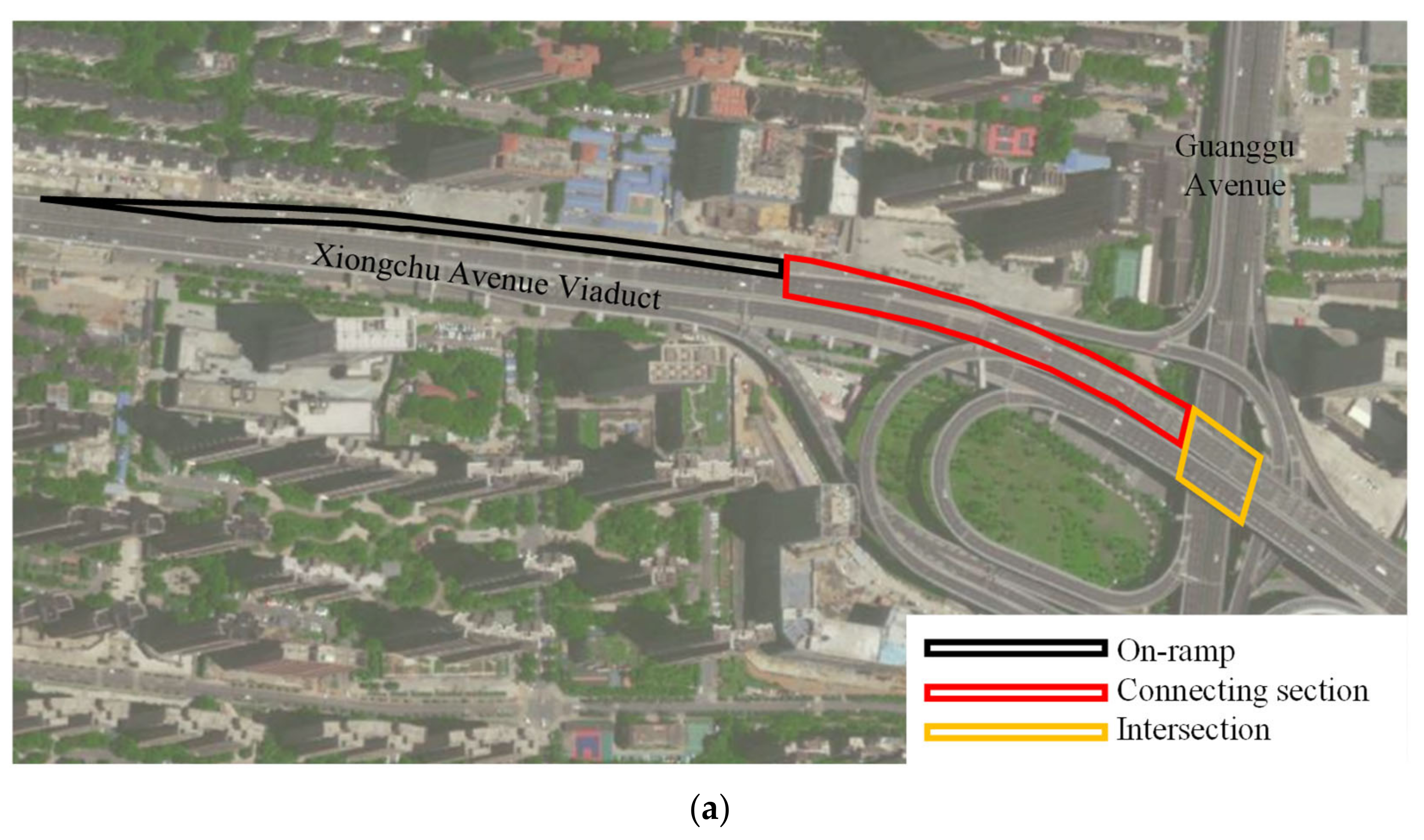
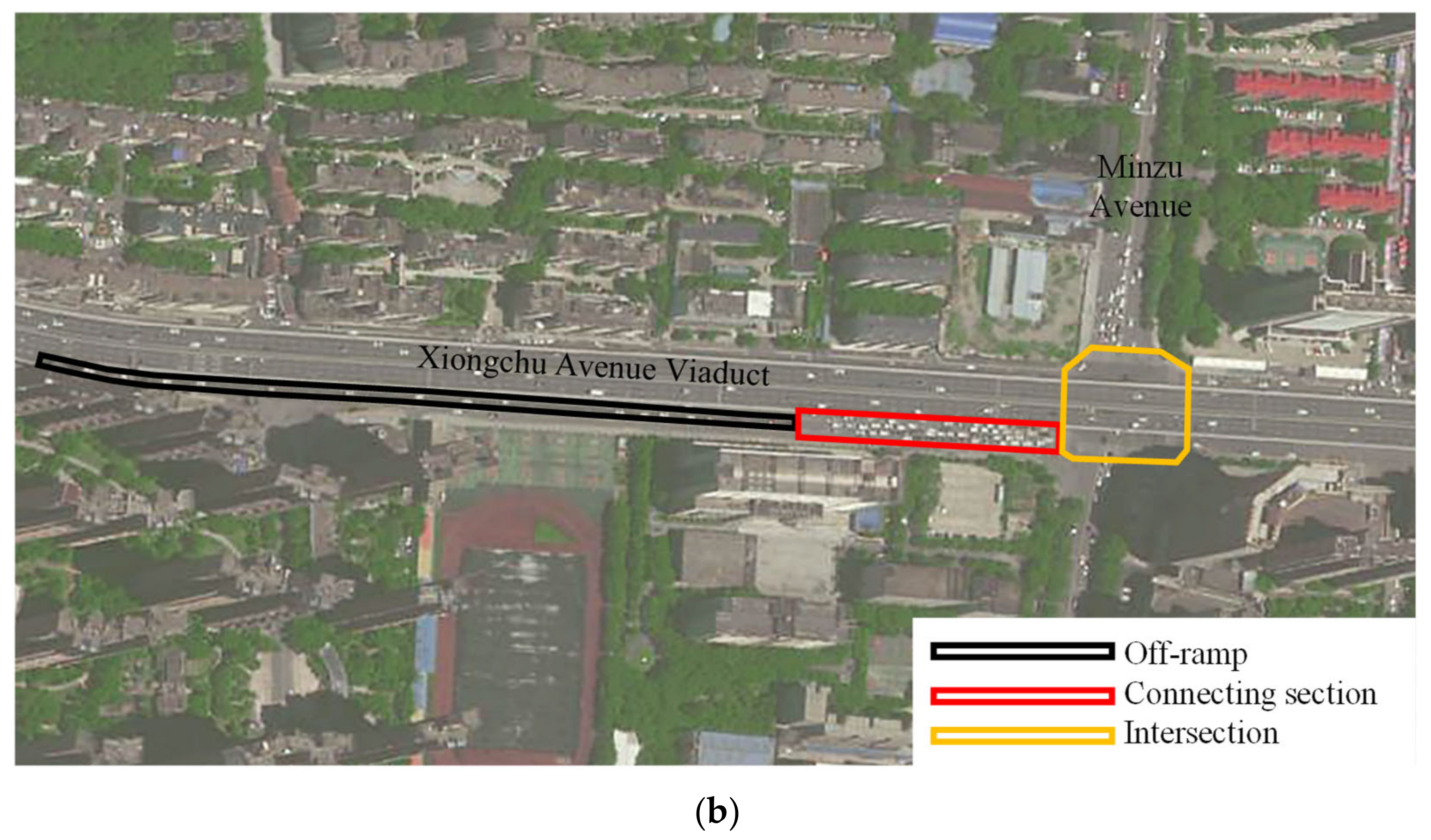

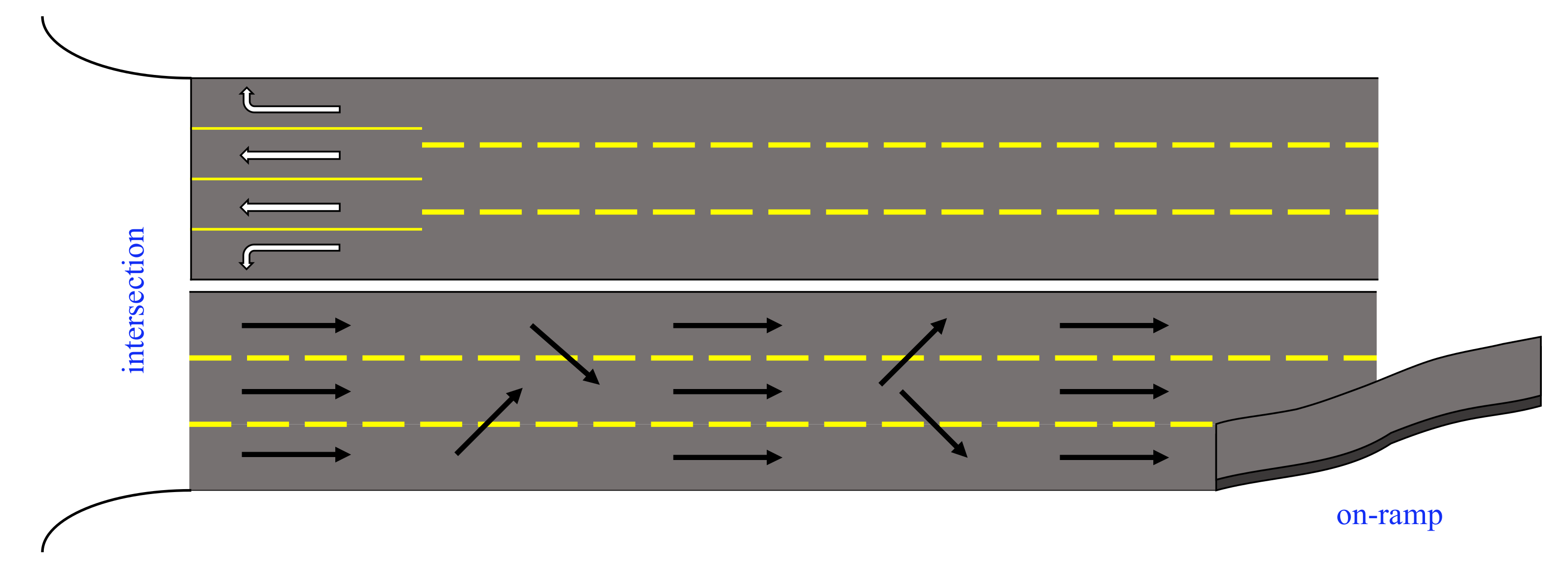
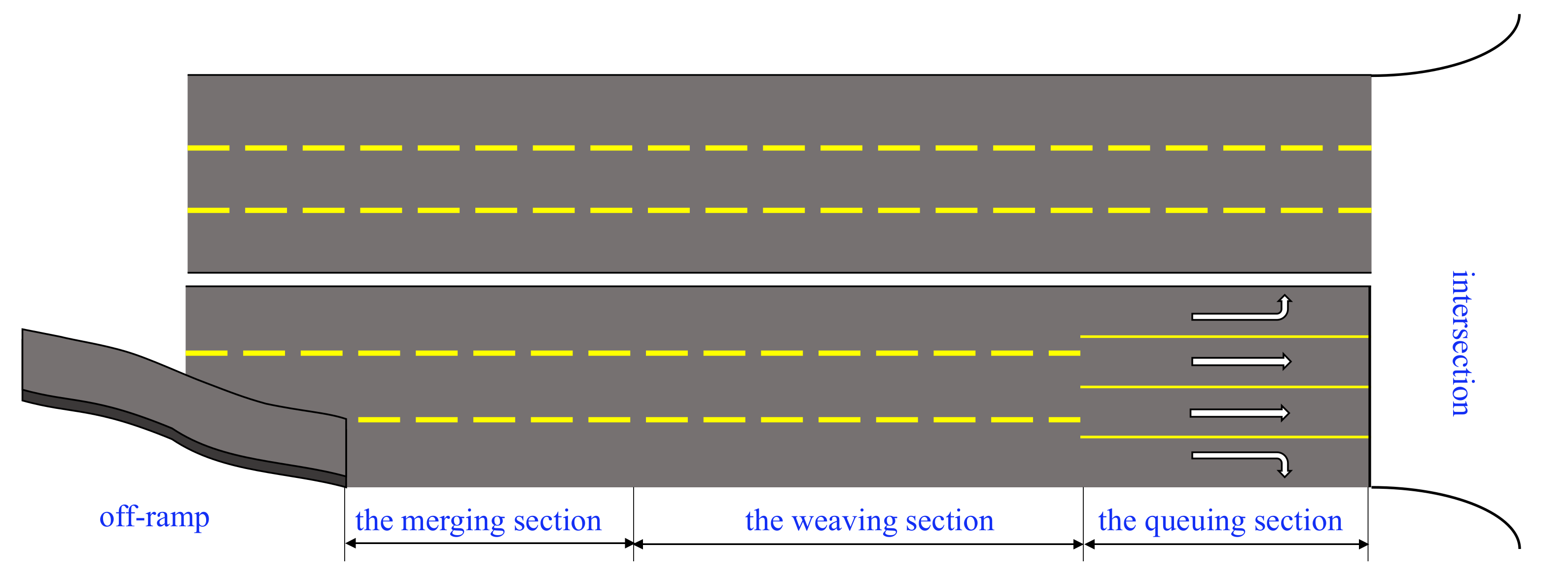
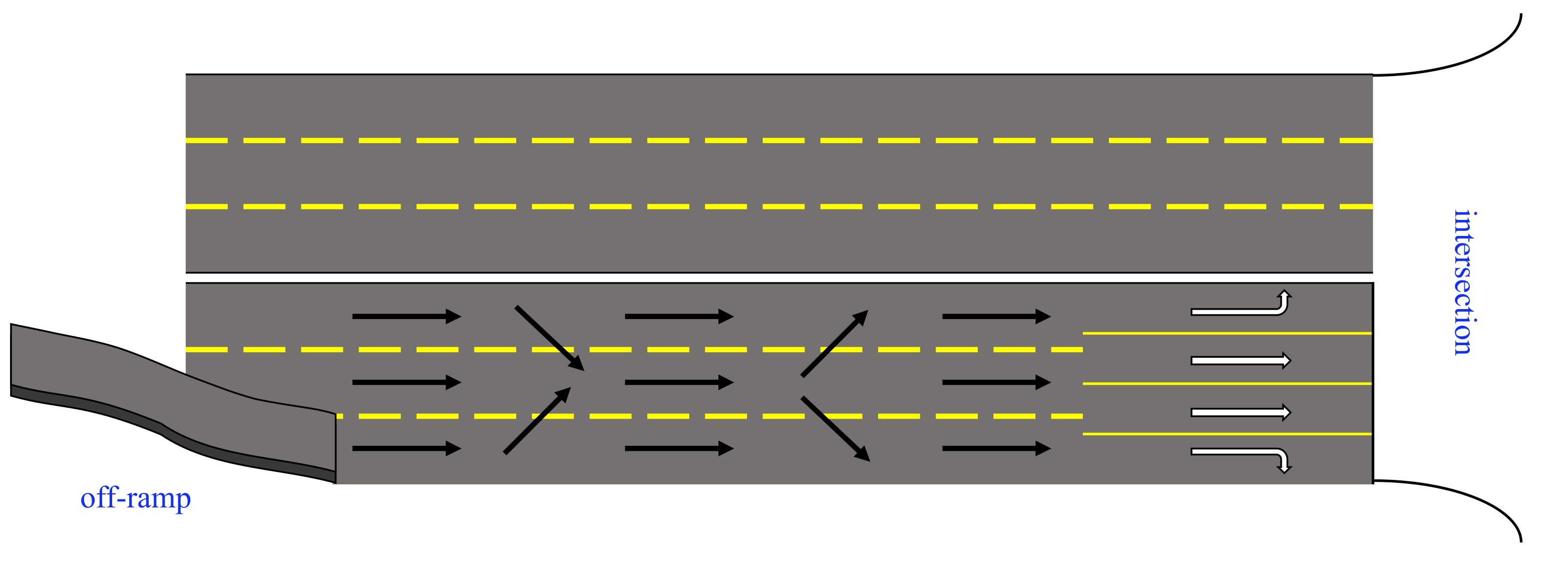

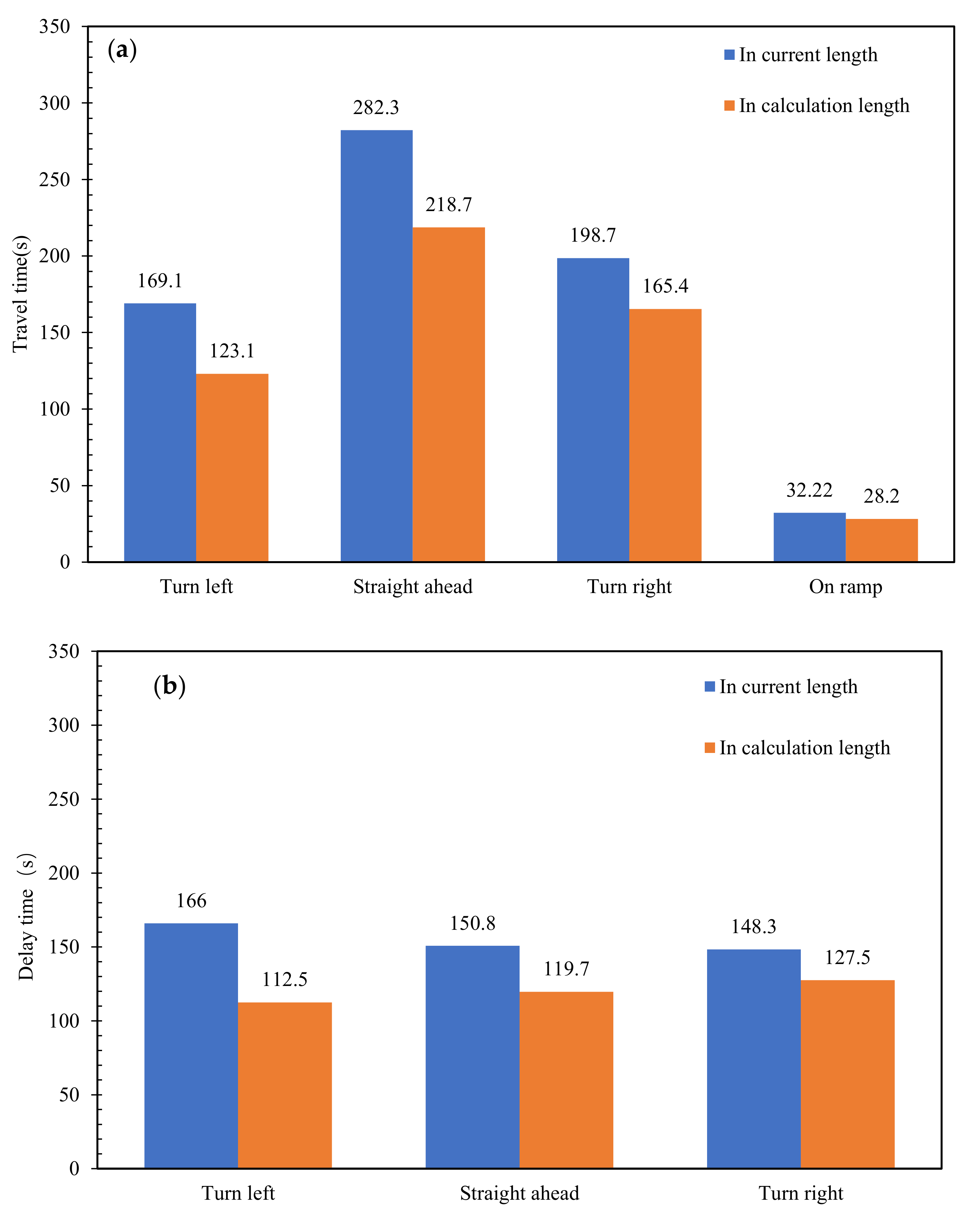
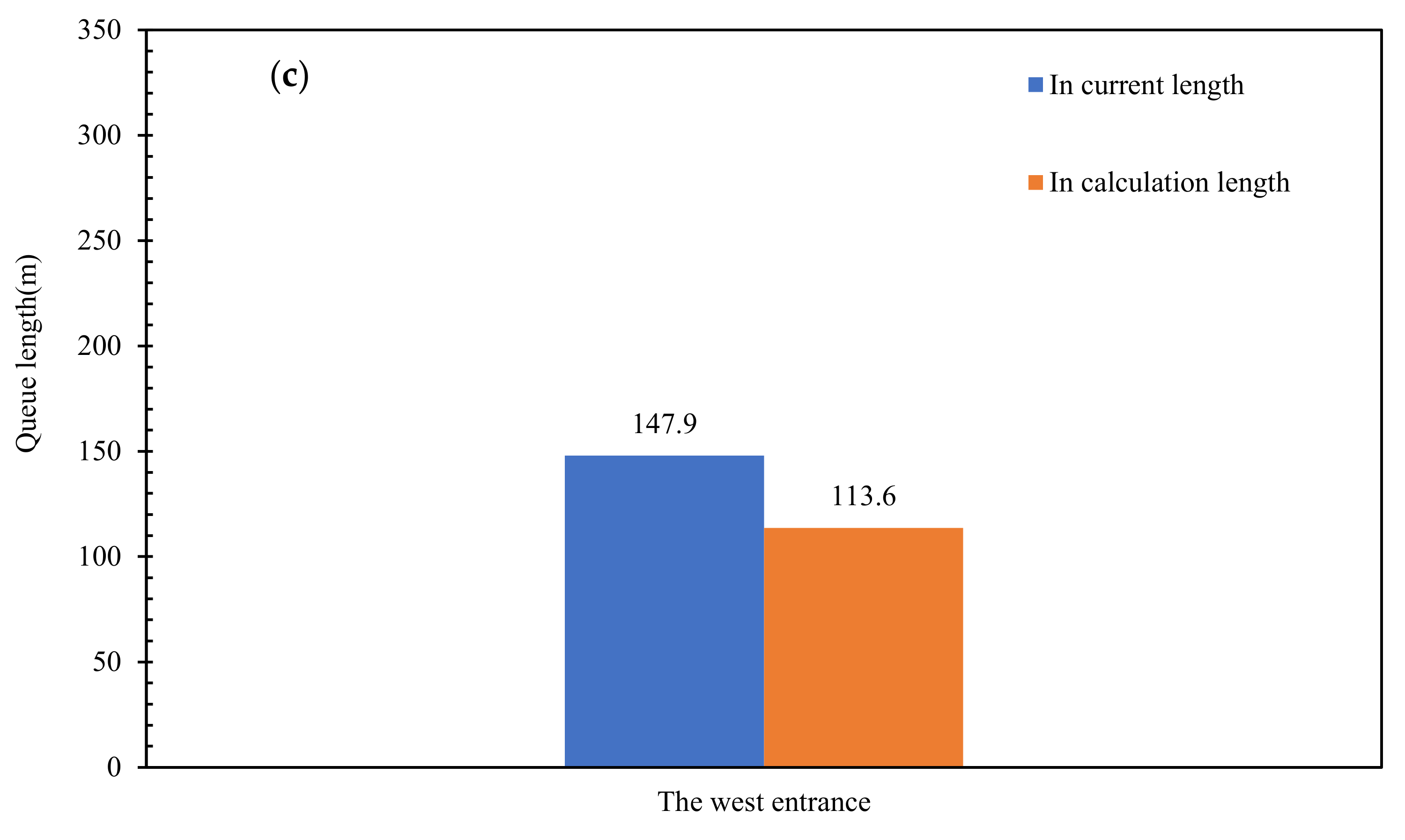
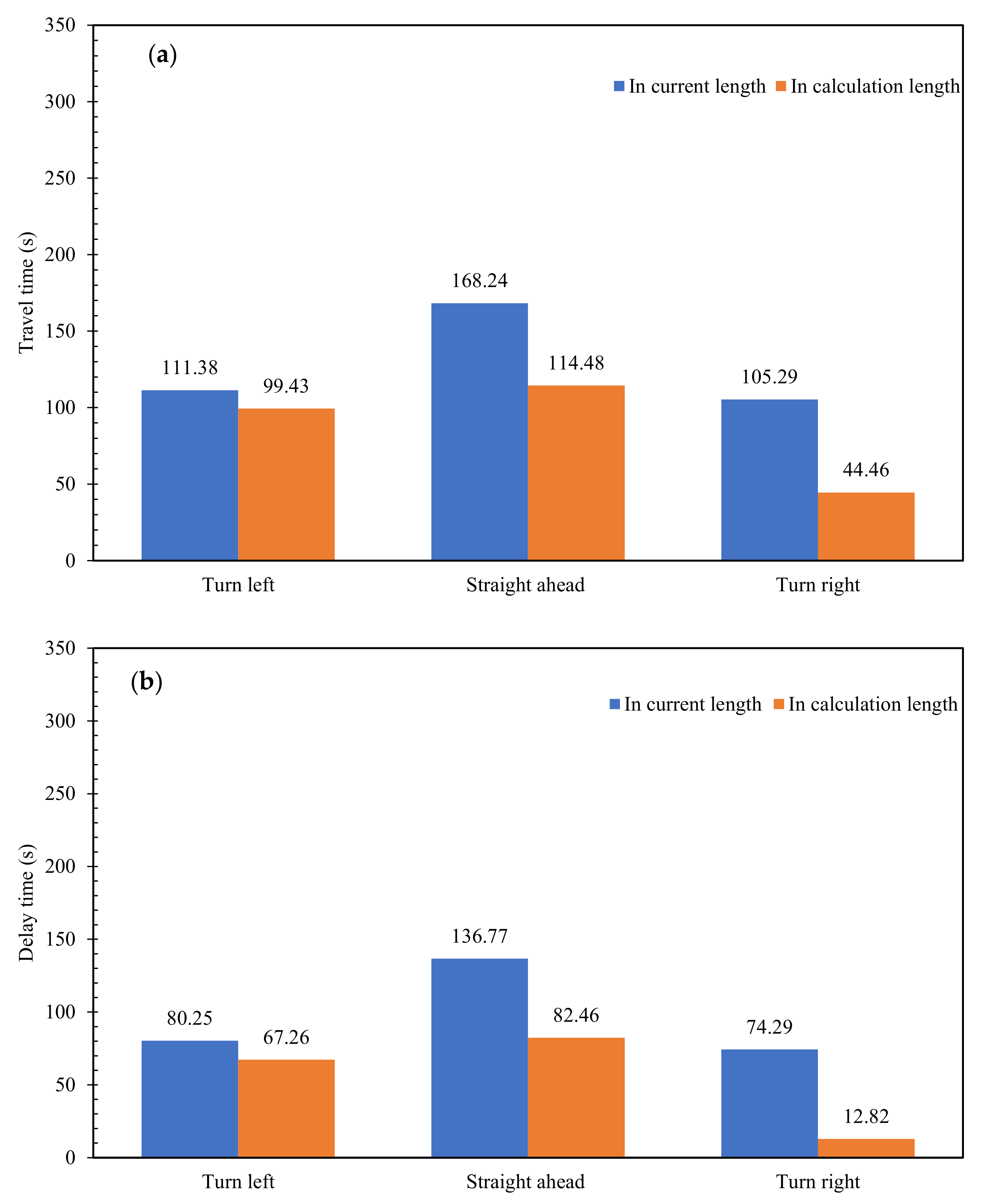
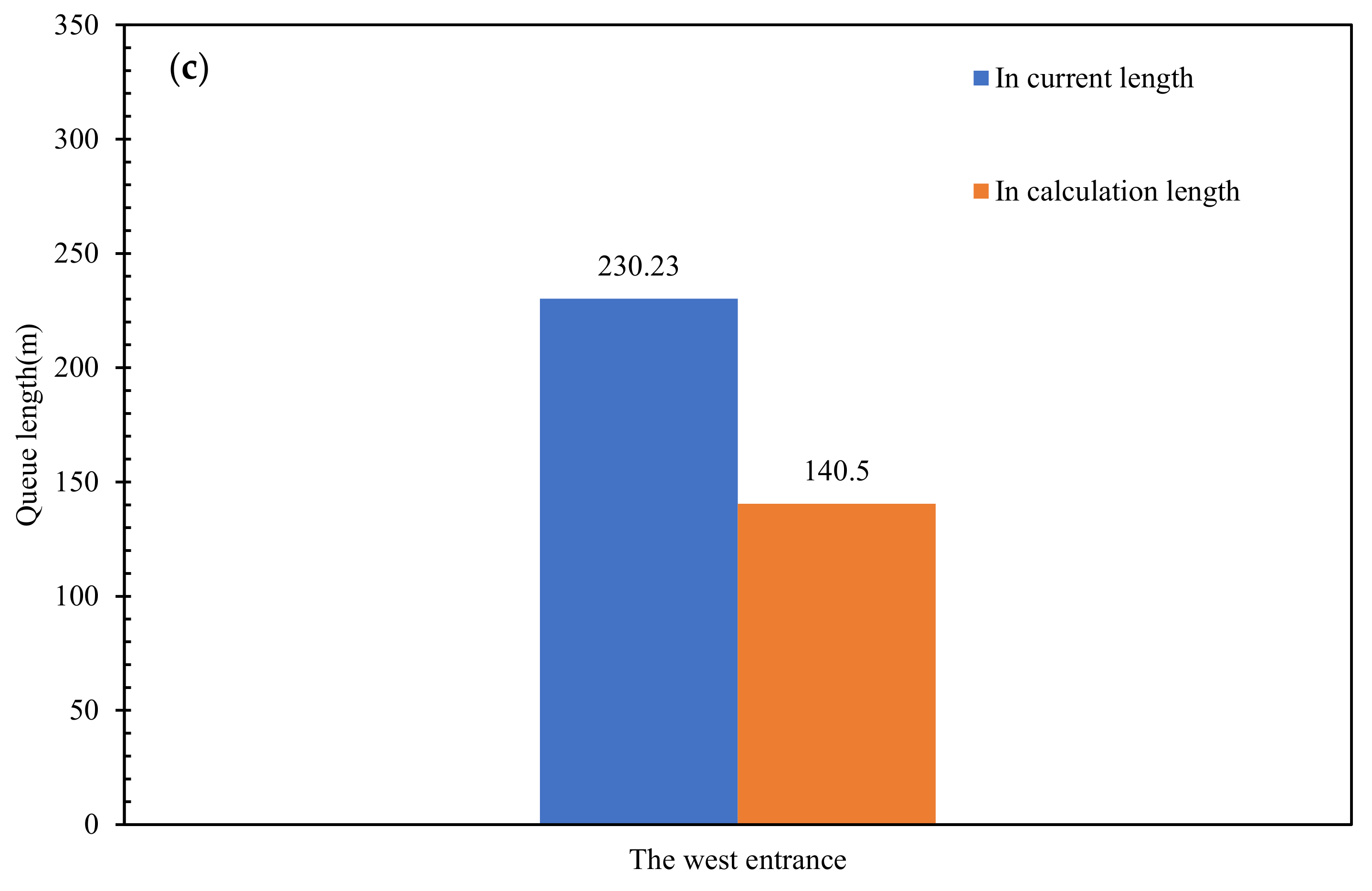
| Phase Number | Phase Condition | Green Time(s) | Yellow Time(s) |
|---|---|---|---|
| The first phase | 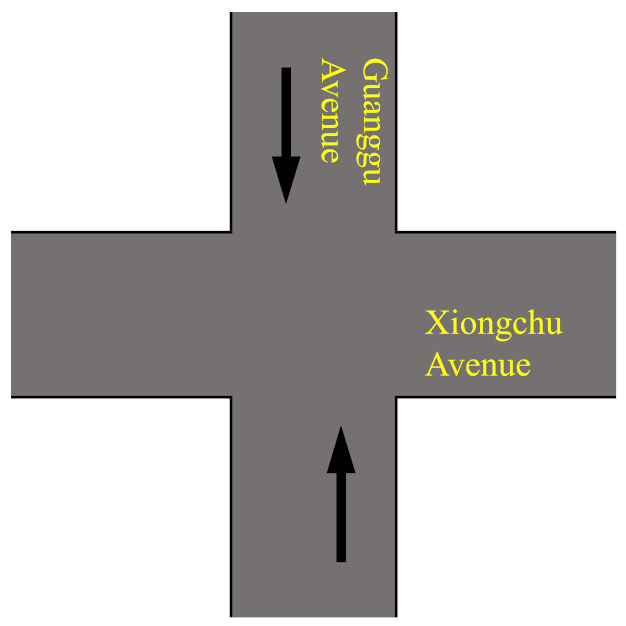 | 35 | 3 |
| The second phase | 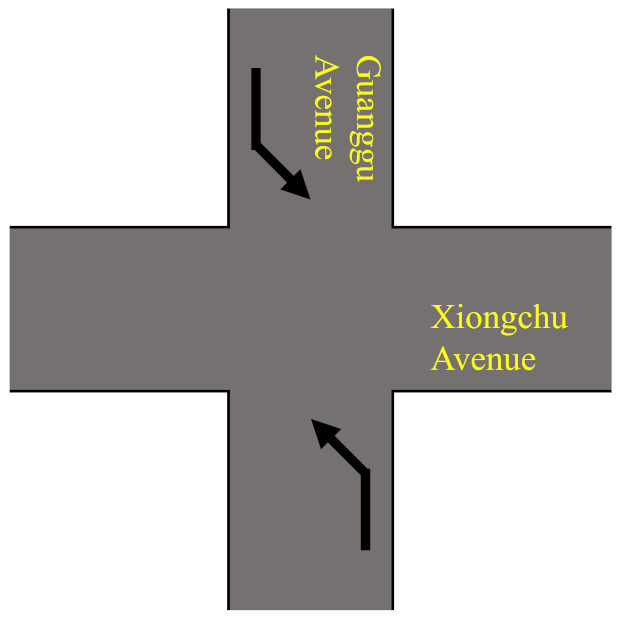 | 30 | 3 |
| The third phase | 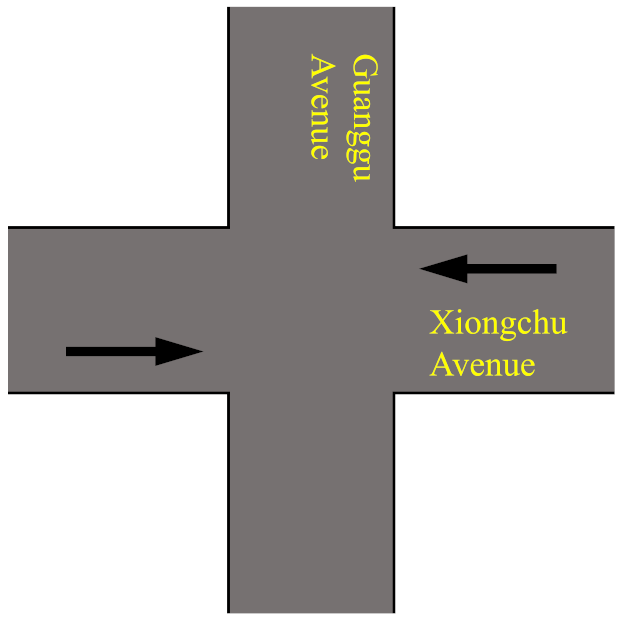 | 30 | 3 |
| The fourth phase | 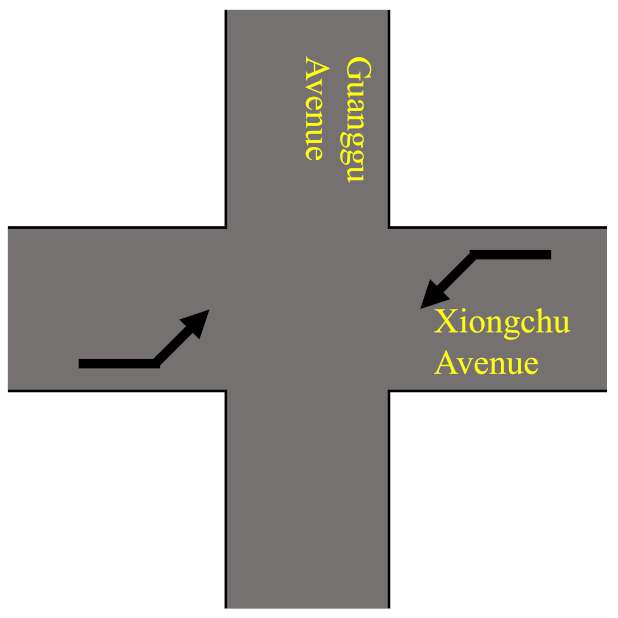 | 30 | 3 |
| Phase Number | Phase Condition | Green Time(s) | Yellow Time(s) |
|---|---|---|---|
| The first phase | 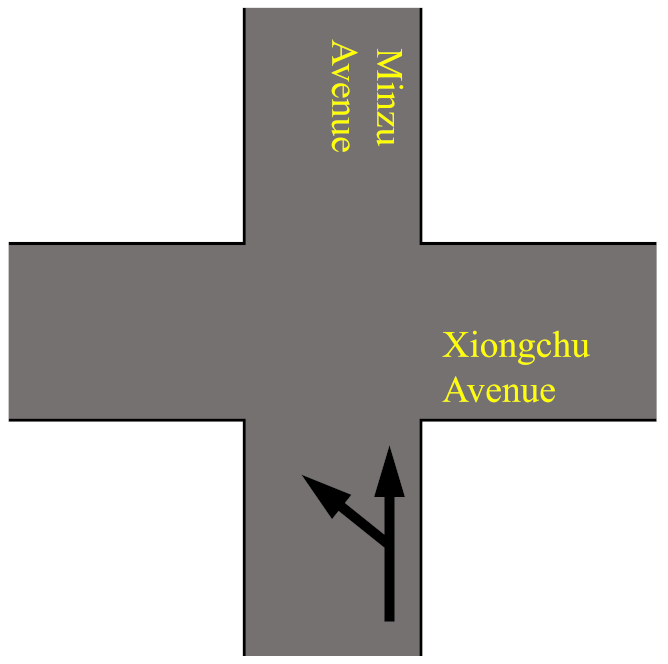 | 48 | 3 |
| The second phase | 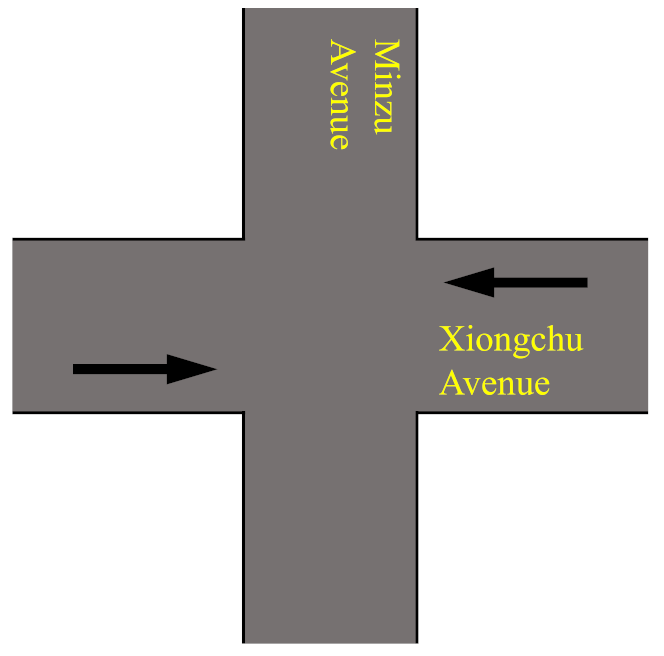 | 38 | 3 |
| The third phase | 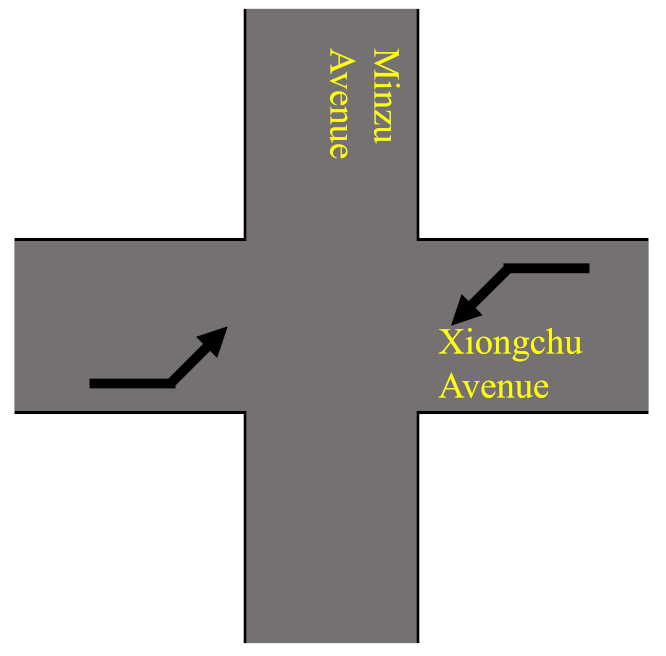 | 35 | 3 |
| The fourth phase | 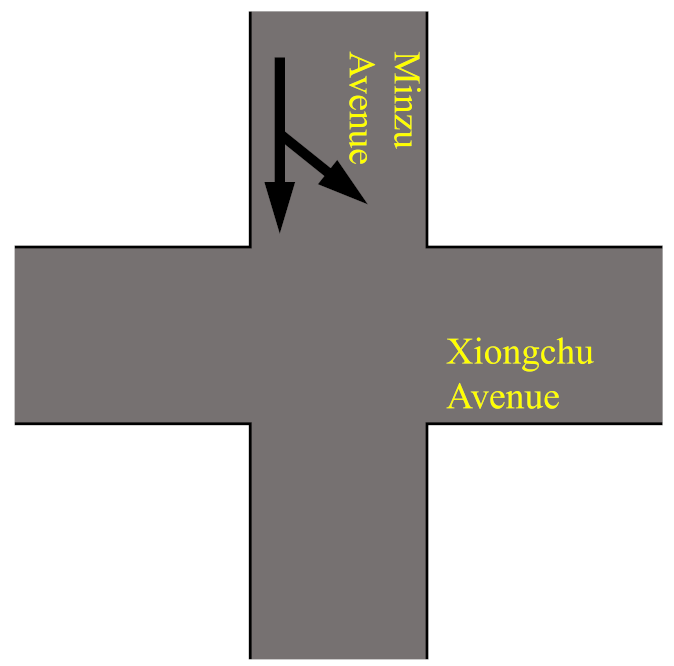 | 48 | 3 |
| Point | The Speed at Which the Vehicle First Enters the Merging Section | The Speed at Which the Vehicle Leaves the Merging Section | The Average Speed of Vehicles in Weaving Section |
|---|---|---|---|
| Speed (km/h) | 38.62 | 22.21 | 36.73 |
| Time | East Entrance (pcu) | South Entrance (pcu) | West Entrance (pcu) | North Entrance (pcu) | On Ramp (pcu) | ||||||||
|---|---|---|---|---|---|---|---|---|---|---|---|---|---|
| L | S | R | L | S | R | L | S | R | L | S | R | ||
| 7:00~7:15 | 58 | 84 | 15 | 77 | 92 | 55 | 101 | 326 | 69 | 22 | 154 | 52 | 190 |
| 7:15~7:30 | 156 | 81 | 24 | 56 | 101 | 43 | 118 | 390 | 52 | 35 | 172 | 43 | 185 |
| 7:30~7:45 | 127 | 136 | 19 | 61 | 99 | 46 | 140 | 315 | 63 | 58 | 178 | 50 | 197 |
| 7:45~8:00 | 135 | 127 | 36 | 55 | 123 | 62 | 158 | 360 | 83 | 39 | 163 | 64 | 191 |
| 8:00~8:15 | 132 | 129 | 18 | 76 | 110 | 55 | 119 | 356 | 47 | 65 | 238 | 59 | 189 |
| 8:15~8:30 | 179 | 131 | 25 | 64 | 90 | 61 | 82 | 373 | 36 | 61 | 250 | 62 | 164 |
| 8:30~8:45 | 132 | 152 | 23 | 59 | 74 | 47 | 111 | 396 | 37 | 37 | 203 | 43 | 170 |
| 8:45~9:00 | 104 | 99 | 25 | 81 | 114 | 42 | 101 | 322 | 46 | 72 | 233 | 39 | 166 |
| Summary | 1023 | 939 | 405 | 529 | 803 | 411 | 930 | 2838 | 433 | 389 | 1591 | 412 | 1452 |
| Point | The Speed at Which the Vehicle First Enters the Merging Section | The Speed at Which the Vehicle Leaves the Merging Section | The Average Speed of Vehicles in Weaving Section |
|---|---|---|---|
| Speed (km/h) | 25.25 | 22.08 | 24.07 |
| Time | East Entrance (pcu) | South Entrance (pcu) | West Entrance (pcu) | North Entrance (pcu) | ||||||||
|---|---|---|---|---|---|---|---|---|---|---|---|---|
| L | S | R | L | S | R | L | S | R | L | S | R | |
| 7:00~7:15 | 76 | 123 | 39 | 75 | 143 | 69 | 110 | 140 | 75 | 32 | 175 | 62 |
| 7:15~7:30 | 88 | 158 | 54 | 63 | 86 | 34 | 138 | 155 | 96 | 62 | 164 | 79 |
| 7:30~7:45 | 76 | 184 | 47 | 102 | 140 | 48 | 93 | 128 | 165 | 96 | 157 | 107 |
| 7:45~8:00 | 75 | 227 | 64 | 93 | 153 | 75 | 80 | 144 | 153 | 57 | 120 | 78 |
| 8:00~8:15 | 64 | 162 | 38 | 60 | 91 | 43 | 120 | 121 | 123 | 98 | 172 | 81 |
| 8:15~8:30 | 75 | 184 | 49 | 96 | 119 | 87 | 70 | 131 | 146 | 77 | 168 | 66 |
| 8:30~8:45 | 66 | 133 | 30 | 121 | 135 | 83 | 100 | 180 | 124 | 54 | 141 | 102 |
| 8:45~9:00 | 73 | 138 | 32 | 64 | 130 | 43 | 94 | 112 | 127 | 60 | 117 | 67 |
| Summary | 593 | 1309 | 353 | 674 | 997 | 482 | 805 | 1111 | 1009 | 536 | 1214 | 642 |
Publisher’s Note: MDPI stays neutral with regard to jurisdictional claims in published maps and institutional affiliations. |
© 2022 by the authors. Licensee MDPI, Basel, Switzerland. This article is an open access article distributed under the terms and conditions of the Creative Commons Attribution (CC BY) license (https://creativecommons.org/licenses/by/4.0/).
Share and Cite
Wang, F.; Gu, D.; Chen, A. Analysis of Traffic Operation Characteristics and Calculation Model of the Length of the Connecting Section between Ramp and Intersection. Sustainability 2022, 14, 629. https://doi.org/10.3390/su14020629
Wang F, Gu D, Chen A. Analysis of Traffic Operation Characteristics and Calculation Model of the Length of the Connecting Section between Ramp and Intersection. Sustainability. 2022; 14(2):629. https://doi.org/10.3390/su14020629
Chicago/Turabian StyleWang, Fu, Dengjun Gu, and Anqi Chen. 2022. "Analysis of Traffic Operation Characteristics and Calculation Model of the Length of the Connecting Section between Ramp and Intersection" Sustainability 14, no. 2: 629. https://doi.org/10.3390/su14020629
APA StyleWang, F., Gu, D., & Chen, A. (2022). Analysis of Traffic Operation Characteristics and Calculation Model of the Length of the Connecting Section between Ramp and Intersection. Sustainability, 14(2), 629. https://doi.org/10.3390/su14020629





